Panel I: Enhancing Collections
Adam King, PhD.
Research Associate Professor
SC Institute of Archaeology and Anthropology, University of South Carolina
Paper Title: Exploring Native American Ritual Beverages through Absorbed Residue Studies
Abstract: Absorbed residue studies have the potential to recover important information from objects housed in museum collections. Most often, these studies focus on detecting food residues absorbed into the matrix of earthenware vessels. In this paper we discuss our efforts to find residues from the preparation and consumption of ancient ritual beverages made by Native Americans in the southeastern US. Some of those beverages contained caffeine (made from cacao or yaupon holly), others had analgesic properties (made from willow), and some had hallucinogenic effects (jimsenweed or Datura). Our results reveal the difficulties and pitfalls of conducting absorbed residues studies and the unique challenges presented by working with museum collections.
Bio: Adam King serves as Research Associate Professor in the South Carolina Institute of Archaeology and Anthropology at the University of South Carolina. He received a B.S. in Finance from Penn State University in 1987, M.A. in Anthropology from University of Georgia in 1991, and a Ph.D. in Anthropology from Penn State University in 1996. His research interests focus on the early history of Native Americans, particularly during the Mississippian Period (AD 1000-1600). Dr. King has ongoing research projects exploring the development of Mississippian communities in the Etowah River Valley of northwestern Georgia and the Middle Savannah River Valley on the Georgia-South Carolina border. His research attempts to understand how Mississippian societies in these areas came into being and changed over the course of their individual histories using traditional archaeological excavation coupled with remote sensing, the exploration of ancient imagery, and absorbed residue studies.
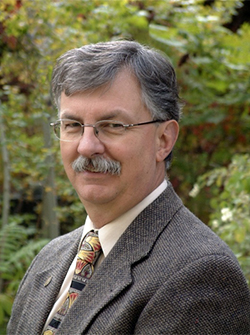 Bob Pickering, PhD.
Bob Pickering, PhD.
Professor of Anthropology
University of Tulsa
Paper Title: Science behind the exhibit: Employing new technologies to explore the past
Abstract: Preparation for the exhibition, West Mexico: Ritual & Identity included an accelerated effort to employ a variety of technologies to analyze the Gilcrease collection in new ways in an effort to provide deeper insights into this fascinating culture. Taken together these efforts have helped re-contextualize objects and has helped created more detail in the “artifact biography” of individual pieces and thereby, providing a better understand of the entire corpus of ceramic figures.
Endoscopy, CT scanning, entomology, DNA analysis, and residue analysis have complimented more traditional techniques of thermoluminescence and radiography to examine the collection. This paper presents the goals for such analysis, the preliminary results, and an outline of potentially fruitful future directions.
 Michael B. Toth
Michael B. Toth
President, R.B. Toth Associates
Honorary Research Associate
University College London
Paper Title: Parchment, Papyrus & Pixels: Integrating data and technologies to support cultural heritage studies
Abstract: Advanced multispectral imaging systems empower museum curators, researchers and preservation specialists to glean important new information about their collection objects for evaluation and study. Current multispectral imaging systems yield not just quality images, but also provide institutions with integrated image data and metadata needed to offer new insights into manuscripts and printed works. Multispectral imaging offers new insights into historic objects, including those at the Gilcrease Museum. Based on techniques and technologies developed during imaging work in a range of institutions – from the Walters Art Museum to the Library of St. Catherine’s Monastery in the Sinai and University College London – spectral imaging studies have revealed obscured text, drawings and production details. With this new tool for non-destructive analysis, museums are now able to effectively integrate multispectral imaging with current workflows to support interdisciplinary research.
Bio: With over 25 years of experience in program management, systems integration, and strategic planning, Mike has led teams of scientists, scholars and technical experts as they help museums, libraries, archives and other institutions make more data widely available. He has provided program and technical management support for numerous cultural heritage projects. From the Sinai to California, he and his teams support institutions across the United States, Europe and the Middle East, working closely with scientists, scholars and institutional staff. With them he provides the planning, integration and research development needed for efficient digital and multispectral imaging research and access.
Panel II: Enhancing Conservation and Preservation
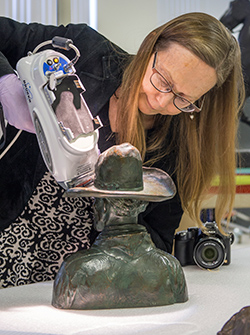 Ann Boulton
Ann Boulton
Associate Conservator
Gilcrease Museum
Paper Title: Authenticity in Relation to Art Conservation: Using Technology to Assess Art Objects and their Authentic Nature
Abstract: The material authenticity of a work of art resides in the originality of its material construction and chemical composition—its historical and physical material essence. The identification of artists’ materials and construction techniques as distinct from later restorations and deterioration is the foundation of modern art conservation practice and an essential prerequisite for proposing effective treatment of unstable or disfigured art. This paper will present a series of case studies of art objects to explore how various technologies aid the conservator in examination and condition assessment of these objects. Ultra-violet light, X and gamma radiography, photomicrography, 3-D laser modeling, pigment analysis, thermoluminescence and other techniques will be discussed.
Bio: Ann Boulton has been a practicing objects conservator for 31 years. She received her B.A. in Fine Arts at the University of New Mexico in 1979 and her M.A. and Certificate of Advanced Study in Conservation of Historic and Artistic Works from the State University of New York College at Buffalo in 1985. After internships at the National Gallery of Art and the Smithsonian she was an Objects Conservator for three years at the Walters Art Museum in Baltimore. Following ten years in private practice she became the staff Objects Conservator at the Baltimore Museum of Art and held that position for 7 years. This position lead to an in depth study of the bronze sculpture of Henri Matisse published by Yale University Press in the exhibition catalog Matisse Painter as Sculptor in 2007. In 2008 she relocated to Oklahoma City for personal reasons and began working part time as Associate Conservator at the Gilcrease Museum where she curated the exhibition Frontier to Foundry in 2015. She consults regularly at other museums in the region including the Oklahoma City Museum of Art, The Fred Jones Jr. Museum of Art at the University of Oklahoma, The National Cowboy and Western Heritage Museum, the Philbrook Museum of Art and The Amon Carter Museum of American Art.
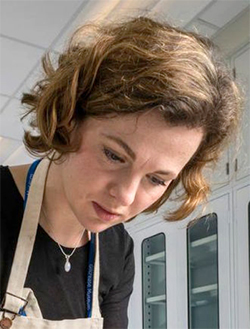 Joanna Didik
Joanna Didik
Chief Conservator
Gilcrease Museum
Abstract: The research is undertaken to determine the conservation treatment and project workflow for Conway Collection (1512-1857) records owned by Gilcrease Museum. From the conservation point of view the main concern is the presence of iron gall ink as well as the physical form of the records. The goal of the project is to design conservation treatment addressing specific problems within the Conway Collection through application of chemical and physical tests as well as working with technologies such as XRF, RTI and UV. The extent and severity of iron gall ink corrosion will be assessed its implication for handling and future usage incorporated into the project.
Bio: Joanna Didik brings a holistic approach to collection care and preservation in museums; she is a Fine Art Conservator, specializing in conservation of paper and leather based objects. Within the Museum setting, she brings understanding of the physical object through scientific investigation and uses chemistry and its principles to increase longevity. Joanna is a member of the American Institute of Conservation of Historic and Artistic Works and International Institute of Conservation.
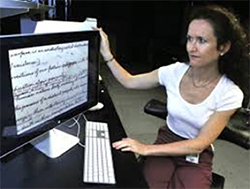 Fenella G. France, PhD.
Fenella G. France, PhD.
Chief of the Preservation and Testing Division
Library of Congress
Paper Title: Optical Challenges – Advancing the Capture of Hidden Content from Heritage Collections
Abstract: The utilization of spectral imaging to include transmitted and other illumination modes expands the capacity of non-invasive technologies to capture archival and museum collection information that is often obscured or degraded due to heavy redactions, or the impact of treatments and environment. An example of this is the recovery of obscured information on an original music score. The Concerto for Orchestra, written by Béla Bartók in 1943, was one of his best-known and most popular works. Bartók revised the piece in 1945, adding additional sections on many pages, in some places being up to four layers. These layers could not be removed due to the document being laminated later. Many historic documents have been heavily redacted either by the original author to expunge and remove the earlier text, or by latter readers. Recovery of the original text, especially from founding father documents allows an exciting glimpse into the previously unknown past.
Bio: Dr. France is Chief of the Preservation Research and Testing Division at the Library of Congress and is responsible for developing imaging and non-invasive technologies for use in prevention of environmental degradation to collections. Her current focus is the development of spectral imaging techniques and increasing links and access between scientific and scholarly data, enabling better interpretation and visualization of linked data for humanities. Dr. France received her Ph.D from Otago University, New Zealand. After lecturing at Otago, she was the research scientist for the Star-Spangled Banner project at the Smithsonian Institution. She serves on a range of standards and professional committees for cultural heritage preservation and maintains close links and collaborations with colleagues from academic, cultural, forensic and federal institutions.
Featured Speaker
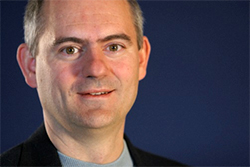 Brent Seales, PhD.
Brent Seales, PhD.
Professor and Chairman, Department of Computer Science
Director of the Center for Visualization and Virtual Environments
University of Kentucky
Paper Title: Digital Unwrapping: Homer, Herculaneum, and the Scroll from Ein Gedi
Abstract: Progress over the past fifteen years in the digitization and analysis of text found in cultural objects (inscriptions, manuscripts, scrolls) has led to a new and astonishing discovery. In this talk I will tell the story of emerging methods for imaging and analysis culminating in a personal account of the discovery, the people involved, and the technical approaches used.
Bio: Dr. Brent Seales is Professor and Chairman of the Department of Computer Science and Director of the Center for Visualization and Virtual Environments (Vis Center) at the University of Kentucky. He earned his Ph.D. at the University of Wisconsin-Madison and was a Postdoctoral Researcher at the French National Institute for Research in Computer Science and Control (INRIA), Sophia-Antipolis, France, before joining the Computer Science Department at the University of Kentucky. In the 2012-13 academic year he was a Visiting Scientist at Google in Paris, France. His research program centers around digital imaging and computer vision applied to problems in the digital restoration of antiquities, surgical technology, and data visualization. The digital recovery by Seales of the readable text within the Ein Gedi scroll was recognized by Christianity Today magazine as the most significant discovery in biblical archaeology of 2015.
Panel III: Enhanced Access and Accessibility
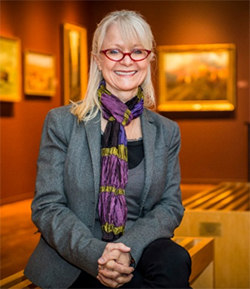 Diana Folsom
Diana Folsom
Director of Digital Collections
Gilcrease Museum
Paper Title: The Art of Integration: GLAM in the Gilcrease Online Collections
Abstract: During the last five years, Gilcrease Museum has focused significant effort on construction of the technological foundation to enable sharing its collections online so that 450,000 diverse collection items will be searchable together.
Taking cues from the GLAM movement, which refers to global endeavors to reunite materials from Galleries, Libraries, Archives and Museums, the collections research site was designed (and launched with 20,000 items earlier in 2016) so that online visitors may explore works of art, library books, archival letters, manuscripts, maps, photographs and archaeological items at the same time, in the same place. This new site begins to open up relationships between diverse items in a direct way and move toward fulfilling the dreams of the GLAM community. Gilcrease Museum’s Director of Digital Collections, Diana Folsom, will describe the methods that are leading to extraordinary results.
Bio: With a background in studio art and a technology career that began in the field of Education Technology (Edtech), Diana Folsom has developed a passion for sharing collections online during her 25 year career in museums. As Director of Digital Collections at Gilcrease Museum, she brings creative solutions to the intricate problems found in digitization projects.
During her tenure at the Los Angeles County Museum of Art (LACMA), she participated in significant projects that helped move the museum technology field forward in new directions such as the “AMICO” project, the Getty’s “Electronic Cataloguing Initiative (ECI)”, the Getty’s “Online Scholarly Catalogue Initiative (OSCI)”, the IMLS-funded “Steve” social tagging research project, the IMLS-funded “Steve-in-action” project, the IMLS-funded “T3 – Text, Tags and Trust” project. She also served for several years on the IMLS review panel for the National Leadership grant awards in Washington, DC.
As part of the Gilcrease Museum team, Ms. Folsom directs the digitization efforts and has brought the collection and team members into the IMLS-funded “Native Artists and Scholars Bring Past to Present: Multi-Discipilnary Perspectives for Mississippian Culture Pottery”, as well as the IMLS and Mellon-funded “American Art Collaborative” so that the Gilcrease can become part of the American Art Cloud on the semantic web.
Ms. Folsom participated in the AAM Media and Technology Standing Professional Committee (SPC) for over ten years where she played many roles, including Program Committee Chair, National Program Committee, MUSE Awards Committee and finally as Chair of the SPC. Recently she served for three years on the Executive Board of the Museum Computer Network (MCN).
 Emanuelle Delmas-Glass
Emanuelle Delmas-Glass
Collections Data Manager
Yale Center for British Art
Paper Title: Linked Open Data and IIIF in Support of Museums’ Educational and Research Mission
Abstract: Cultural heritage institutions have been digitizing their collections for many years and while publishing digital assets and metadata online has had a positive impact on the relevance of these institutions in our connected world, the seamless reuse of these assets has remained a difficult proposition. The author will discuss a technological strategy that eases the implementation of digital projects and sustain them for the long term. The technology considered challenges the current paradigm, which isolates each institution. Rather the digital strategy chartered offers new opportunities to leverage the rich knowledge created by museums and let them engage deeply with their audiences.
Bio: Emmanuelle is currently the Collections Data Manager at the Yale Center for British Art, where she started working in 2006 as the Collections Catalog Specialist. In her current role, she oversees the creation of and access to the museum’s collections metadata. She plays the lead role in ensuring its intellectual and technical integrity. She identifies and implements new data standards and technologies to disseminate to as wide an audience as possible as well as to support the scholarly mission of the Center. Under her guidance, the YCBA has launched its first online collections catalog. Her primary responsibilities are creating, modeling and publishing the museum’s collections information in an online environment as well as in Linked Open Data format to support the Center’s various digital scholarship collaborations with world-wide institutions. Overall she is interested in metadata interoperability issues and deep collaboration across libraries, archives, and museums, and as such she has been working with the CIDOC-Conceptual Reference Model and International Image Interoperability Framework (IIIF). She has been a CIDOC board member since 2013. As a member of the ICOM-CIDOC Working Group Data Harvesting and Interchange, she has contributed to the development of LIDO. She previously worked at the Williams College Museum of Art and the Louvre Museum. She has a Master’s of Art History from Virginia Commonwealth University.
Keynote Speaker
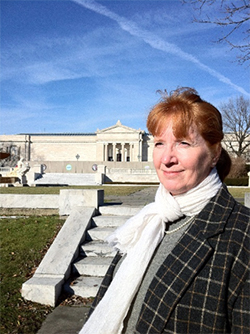 Holly Witchey, Ph.D
Holly Witchey, Ph.D
Director of The Wade Project
Western Reserve University
Paper Title: The Ringmaster’s Secret
Bio: Holly Witchey has a Ph.D. in European Painting and Sculpture and twenty-five years of experience as a museum professional. She is currently Director of The Wade Project at Western Reserve Historical Society in Cleveland, Ohio a multi-year collaborative project to create a new model for studying the role of families in the development of urban cultural centers in the United States. In 2016 she was named as one of the most interesting people in Cleveland by Cleveland Magazine.
She teaches ethics and convergence issues online in the AAP Master of Arts in Museum Studies program for Johns Hopkins University, and traditional museum studies at CWRU where she is adjunct faculty in the Department of Art History. Her research interests currently focus on North American perceptions of museums prior to the building of the nation’s first great museums in the late 19th century.
Witchey served on the board of directors for MCN and as the AAM Board-appointed member of the National Committee for Archives, Libraries, and Museums (CALM). Other professional appointments include: (2004-2007) Chair of AAM’s Media and Technology Standing Professional Committee (M&T), (2010-2014) Co-Principal Investigator for the NMC Horizon Report>Museum Edition and lead blogger for MIDEA, a non-profit organization with the goal to provide practical knowledge about emerging technologies that museums can use to advance their missions (2011-2014).
From 1991-1999 she was Associate Curator of European Art and Manager of New Media at the San Diego Museum of Art, and from 2000-2009 she was Director of New Media at the Cleveland Museum of Art. Witchey is the author of Progressive Vision the History of Downtown Cleveland (1986), the co-author of The Fine Arts in Cleveland: An Illustrated History (1994), An Uncommon Mission (2000), and, most recently, Cocktail at the Museum.
